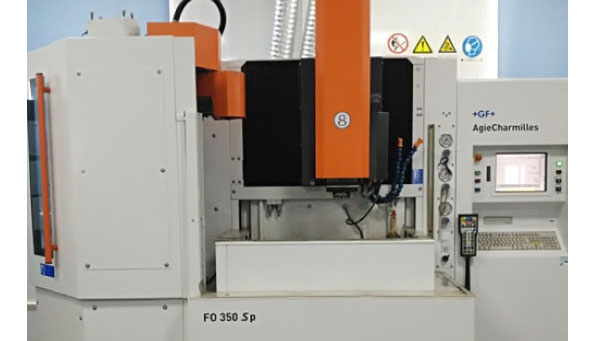Managing EDM Tool Wear to Improve Longevity and Reduce Costs
As a leading plastic injection mold manufacturer in China, Elite is dedicated to delivering top-quality molds and molded parts with competitive pricing. A key factor in maintaining our high-quality standards while controlling costs is the effective management of EDM (Electrical Discharge Machining) tool wear. Tool wear directly impacts the longevity of the molds and the overall efficiency of the production process. In this article, we will explore strategies to manage EDM tool wear, improve tool longevity, and reduce production costs at Elite.
Understanding EDM Tool Wear
Tool wear in EDM refers to the gradual erosion of the electrode during the machining process. As electrical discharges remove material from the workpiece, they also wear down the electrode, reducing its effectiveness and precision over time. Managing this wear is essential to ensure high-quality machining and to minimize costs associated with electrode replacement.
What Causes EDM Tool Wear?
Tool wear is primarily caused by the intense heat generated during electrical discharges between the electrode and the workpiece. Factors such as discharge energy, electrode material, and the type of workpiece material all play a role in how quickly the electrode wears down.
Key Factors Influencing Tool Wear:
- Discharge energy: Higher energy levels result in faster material removal but also accelerate tool wear.
- Electrode material: Different materials, such as copper and graphite, wear at different rates.
- Workpiece hardness: Harder materials like steel and carbide cause more electrode wear compared to softer materials.
The Impact of Tool Wear on Mold Production
At Elite, tool wear management is critical for ensuring the precision, durability, and cost-effectiveness of our plastic injection molds. Understanding how tool wear affects production helps us take the necessary steps to reduce its impact.
1. Reduced Precision
As an EDM tool wears down, its ability to produce precise cuts diminishes. This can lead to dimensional inaccuracies in the mold, resulting in defects or inconsistencies in the final plastic parts. Managing tool wear ensures that the electrode maintains its shape and precision throughout the machining process.
Effects of Reduced Precision:
- Dimensional errors: Wear can cause variations in the mold cavity dimensions, affecting part quality.
- Increased rework: Worn tools may require reworking or additional finishing, increasing production time and costs.
2. Decreased Surface Quality
Tool wear can also negatively impact the surface finish of the mold. A worn electrode may produce rougher surfaces, leading to poor-quality molded parts that require additional finishing or polishing. This is especially critical for industries where surface quality is essential, such as automotive, electronics, and medical devices.
Effects on Surface Quality:
- Rougher surfaces: Increased tool wear can result in rougher surfaces, reducing the aesthetic and functional quality of the molded part.
- Additional processing: Rough surfaces may require secondary processes, adding to production time and costs.
3. Increased Costs and Downtime
Frequent electrode replacement due to excessive wear increases material costs and leads to more machine downtime. Managing tool wear efficiently allows for longer tool life, reducing the frequency of replacements and minimizing disruptions to the production schedule.
Financial and Operational Impact:
- Higher electrode costs: Frequent replacement of worn electrodes adds to material expenses.
- Production delays: Increased downtime for electrode changes or rework can affect production schedules and lead to missed deadlines.

Strategies for Managing EDM Tool Wear at Elite
At Elite, we implement several strategies to effectively manage EDM tool wear, ensuring that our machining processes remain precise, cost-efficient, and high-quality.
1. Optimizing EDM Parameters
One of the most effective ways to manage tool wear is by optimizing the EDM process parameters. By carefully controlling factors such as discharge energy, pulse duration, and electrode polarity, we can significantly reduce tool wear without compromising machining speed or precision.
Key Optimized Parameters:
- Lower discharge energy: Reducing discharge energy slows down tool wear, though it may slightly extend machining time. This trade-off is often worth the improvement in tool longevity.
- Shorter pulse duration: Shorter pulses generate less heat, reducing wear while maintaining precision.
- Correct polarity: Ensuring the correct polarity of the electrode can reduce wear and improve material removal rates.
2. Selecting the Right Electrode Materials
The choice of electrode material plays a significant role in managing tool wear. At Elite, we use high-quality materials such as graphite and copper, each chosen for its specific advantages in different applications. Selecting the appropriate electrode material helps to minimize wear and maximize machining efficiency.
Electrode Material Selection:
- Graphite electrodes: Graphite is highly resistant to wear, making it ideal for high-speed machining of hard materials.
- Copper electrodes: Copper offers superior surface finishes and slower wear rates, making it a preferred choice for high-precision applications.
3. Regular Tool Monitoring and Maintenance
Routine monitoring of the EDM tool during machining allows us to track tool wear in real time. This proactive approach helps us identify when an electrode needs replacing before it affects machining quality. At Elite, we use advanced monitoring systems to assess tool wear and perform maintenance as needed.
Monitoring and Maintenance Practices:
- Wear tracking: Regularly measuring electrode wear ensures that the tool is replaced before it compromises part quality.
- Timely maintenance: Performing maintenance on EDM machines and electrodes helps to extend tool life and prevent costly repairs.
4. Utilizing Advanced EDM Technologies
At Elite, we invest in advanced EDM technologies that help reduce tool wear and improve machining efficiency. These technologies include automated EDM machines with real-time wear compensation, allowing for continuous adjustments to the machining process.
Advanced Technologies in Use:
- Wear compensation: Automated systems adjust machining parameters in real-time to account for electrode wear, maintaining precision and extending tool life.
- High-speed EDM: High-speed EDM machines optimize the machining process, reducing the impact of tool wear while maintaining fast production speeds.
5. Using Multi-Section Electrode Design
To reduce wear and improve the lifespan of electrodes, Elite often uses multi-section electrode designs. This approach involves dividing the electrode into multiple sections, allowing each part to be used for specific machining tasks. By distributing wear across different sections, we can prolong the overall life of the electrode.
Benefits of Multi-Section Electrodes:
- Extended electrode life: Spreading wear across multiple sections reduces the rate at which each section degrades.
- Cost savings: Fewer electrode replacements are needed, reducing material costs.
- Increased precision: Multi-section designs help maintain the electrode's shape and precision over longer production runs.
How Tool Wear Management Reduces Costs at Elite
Effective tool wear management plays a crucial role in reducing production costs at Elite. By extending the life of our EDM tools and minimizing electrode replacement, we can maintain competitive pricing for our clients while delivering top-quality molds.
1. Lower Material Costs
By managing tool wear efficiently, we reduce the need for frequent electrode replacements. This leads to significant savings in material costs over time, particularly for complex mold projects that require extended machining cycles.
2. Increased Production Efficiency
Minimizing tool wear results in fewer interruptions for electrode changes or rework, leading to increased production efficiency. At Elite, this means we can complete projects faster and meet tight deadlines without compromising quality.
3. Consistent Product Quality
By carefully managing tool wear, we ensure that the precision and surface quality of our molds remain consistent throughout production. This helps reduce the risk of defects, rework, and waste, all of which contribute to cost savings.
Conclusion
Managing EDM tool wear is essential for maintaining precision, reducing costs, and improving production efficiency in plastic injection mold manufacturing. At Elite, we employ advanced strategies and technologies to extend the life of our EDM tools, minimize wear, and deliver high-quality molds at competitive prices. By optimizing EDM parameters, selecting the right electrode materials, and using innovative techniques, we ensure that our clients receive superior products while benefiting from cost-effective manufacturing.
Contact Elite today to learn how our expertise in tool wear management can enhance the quality and efficiency of your next plastic injection molding project.
Related news
Our Certificates
By co-operating with Elite Mold, you have selected one of the most reliable ISO 9001 certified plastic mold manufacturer, Elite Mold as a plastic injection mold manufacturer specializing in plastic injection mold and supplying plastic injection molding services for plastic mold design, prototype makings, mold flow analysis, precise machining, OEM services, ODM services and so on, building custom plastic injection molding. We are committed to enhance the Process optimized and quality of service, shorten lead time and assist in lowering inventory, by providing new products every year to bring in continuous and higher profits for our clients. The ability to produce mold at the International standard, strong engineering and mold design capability, aggressive delivery, competitive pricing and business integrity continues to be the success factor of Elite Mold.










